When it came to choosing how we wanted to do the floor in our van, we wanted it to look nice yet have a durable surface with plenty of tie down options to haul dirtbikes and mountain bikes.
Like most cargo Sprinters, our van came with the factory (gray painted) wood floor and the previous owner installed a sheet of plywood and E track. It provided great tie-down options but was obviously not going to cut it for our build.
We pulled it all up and set aside the factory wood floor since this would be reused as our subfloor. We cleaned and prepped, then sealed all the holes in the metal floor with Sikaflex 221.
Sikaflex 221 works great to seal and bond just about every type of material.
It stays flexible and doesn’t harden.
After all the holes were sealed, 80 mil thickness Fat Mat was laid down on the floor and wheel wells to quiet things down. The 100sq ft kit on Amazon came with a roller, a knife, and two 2×50 ft rolls. A little more than one of the rolls was plenty for the flooring and wheelhouses. I ordered extra to do some of the walls and doors.
A layer of closed-cell foam with a radiant barrier was then installed on top of the FatMat sound deadening material. This foam layer of insulation acts as thermal barrier. We chose this material rather than Reflectix because it seemed more durable to be used under a floor. I didn’t want to worry about the bubbles popping.
It was now time to work on installing L track to secure our bikes. L track (logistic track) is a high-grade aluminum track used to secure heavy loads. It has been used to mount seats in airplanes for years. There are three different styles of L track: standard surface mount, angled surface mount, and recessed mount. We didn’t want to be tripping over the track so we went with the recessed mount. It was a bit more work to do, but it would also work well with securing our vinyl plank flooring.
Most L track comes with prill drilled holes about every 4 inches. Just to make sure our bolt holes aligned properly with the ribs in the floor, I bought recessed L track from Cargo Equipment Corp with any holes in it and drilled my own. It was a very tedious process, but I felt it was required.
Now that the underside of the floor was complete, slits were cut in the factory wood floor to accommodate the recessed L track. In order to reduce the space between the track and the raised ribs in the floor, I cut out the foam insulation where it mounted to the floor.
Once the L tracks were set into place, M6 stainless rivnuts were installed in the floor. Each L track utilizes about 7-8 mounting points (rivnuts and bolts) spaced about 6 inches apart. Washers were added in places like the factory D rings and l track mounting mounts so they would not clamp down too hard on the flooring.
UPDATE NOTE: Nylon washers will be a better alternative in this case due to the differences in metal. Over time, corrosion or rust may form with steel washers.
The floor was now ready for the top layer: faux wood LVP (luxury vinyl plank). Despite what we’ve heard from others about LVP being a bad idea, we decided to go with it anyways. Some concerns were the planks would separate in extreme temperatures causing gaps. We did not want a rubber or cheap-looking vinyl rolled floor though so we went with a “high end” Tranquility LVP flooring from Lumber Liquidators. We glued the flooring down with 3M 90 to hold it from shifting on the factory wood floor but also left an expansion gap at the ends where it meets the L track.
After two solid days, the floor was in and done! Precise cuts were not bothered with around the wheel houses since boxes would be covering those. Oh and I re-taped those wheelhouses with foil tape. We ran out and the duct tape obviously didn’t work out so well.
It feels great to sit back and see the floor completed just how we had pictured it.
For the finishing touches, I added an aluminum strip under the rear factory threshold strip so you can’t see the under-layers of material. (no pic)
Rubber coin grip flooring was glued to the slider step area and finished off with aluminum edging.
Parts and Tools Used
- Sikaflex 221
- 80 mil thickness Fat Mat
- closed-cell foam
- M6 tainless rivnuts
- L track from Cargo Equipment Corp
- rivnut tool





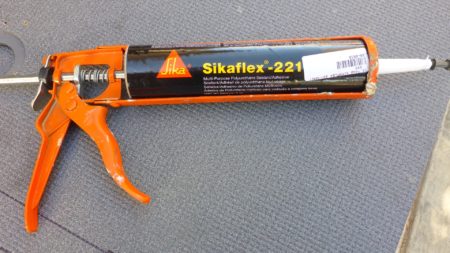














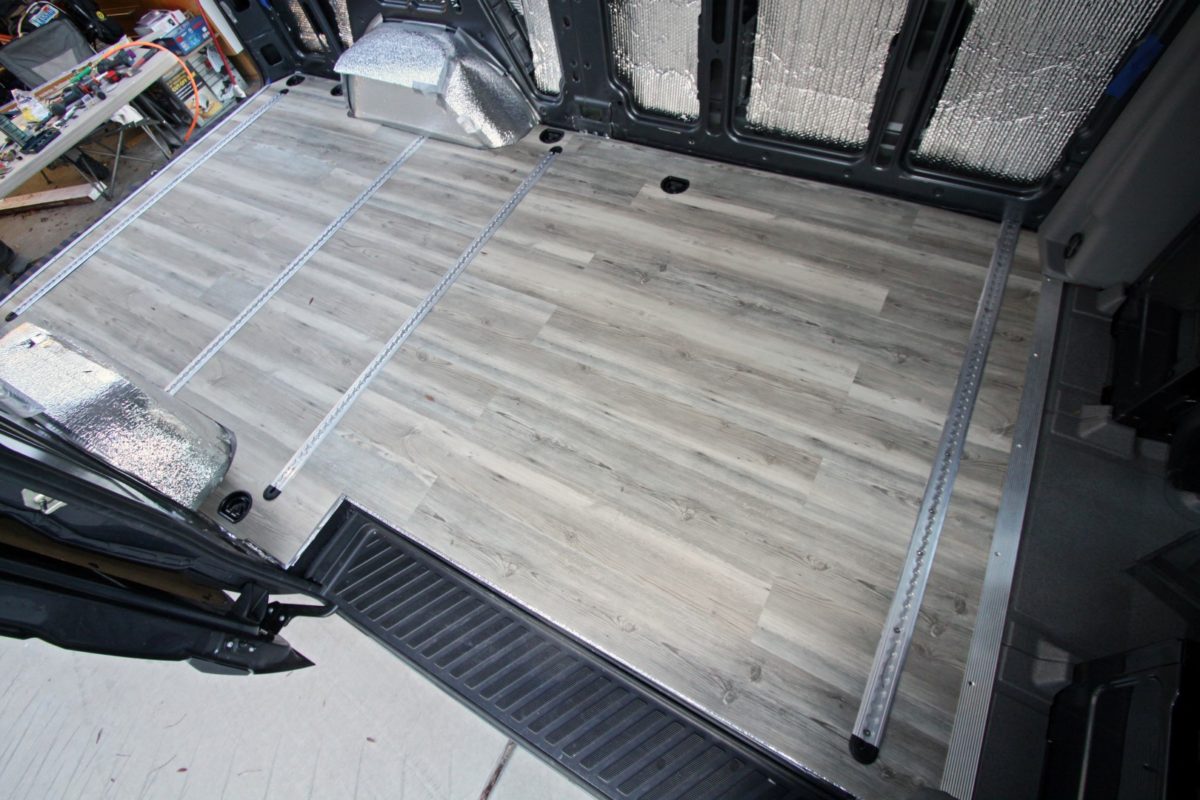





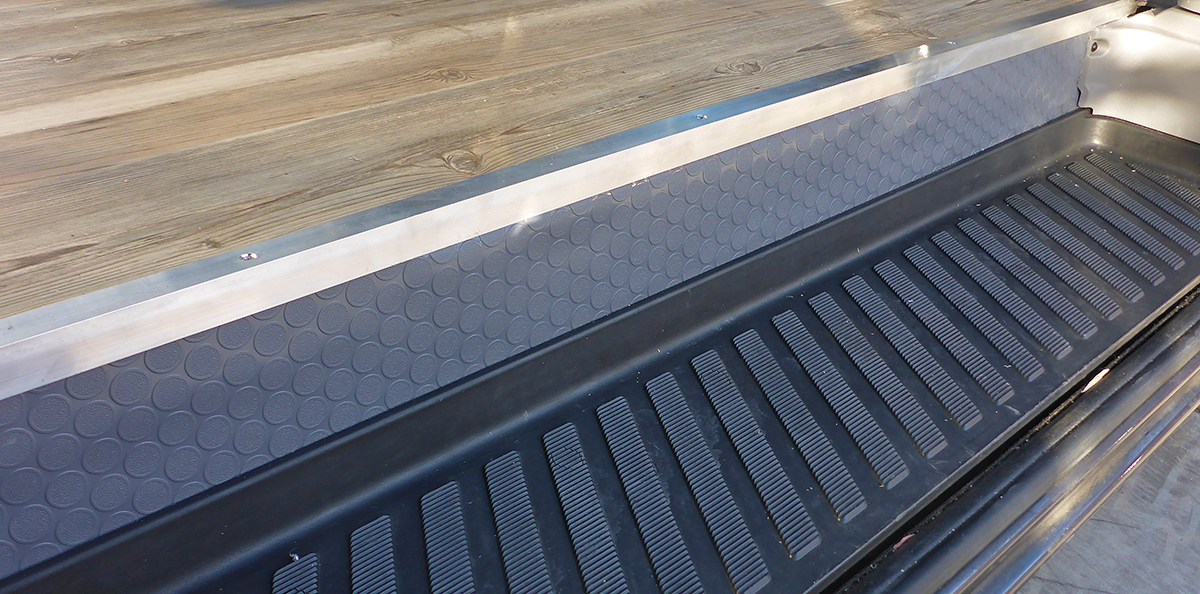




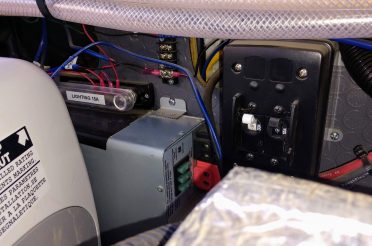
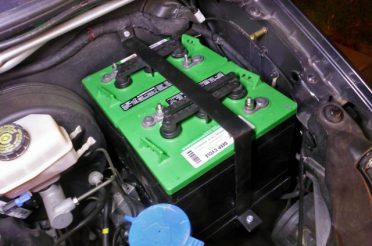


19 Responses
Steve Meerdink
The van looks great! I’ve really enjoyed following your build. Thanks for taking the time to post such thorough info. I just got a 144 crew van and plan to do a build very similar to yours. How has the floor been working out? I would like to do vinyl planks as well, I’m just really concerned about buckling in high heat. Our van sits in the driveway with outside summer temps peaking around 100 (even higher in the van). I’d prefer to not use vinyl sheets but I don’t want to rework the plank floor either. I figured your van has seen some high temps by now and you might have a good readpoint on the plank flooring. Thanks!
Pete
Hi Steve and thanks! The floor has held up great. There has been zero buckling in the summer or major gaps in the winter. We live in Vegas so it gets well above 100 degrees inside the van in the driveway. Just make sure you get a quality product that locks together and I would recommend gluing it down with 3M90. We are still very happy with the floor and we’re glad we went this route. It looks much better than the vinyl sheets. Good luck with your build! You you have an Instagram or blog I can follow your build?
Steve
Great to hear the LVP has held up. I think I’ll go for it too. I’m planning to have some captain chairs installed behind driver and passenger seats. These will bolt down through the finished floor, so I’m also a bit worried about this “pinning” down the planks, contributing to buckling, etc., but I figure this isn’t much difference than the rest of the planks that will be glued down pretty hard. No build blog yet, but I may look into starting one. It’s to get help/ feedback from others!
Pete
I think you’ll be fine. I think they contract more than expand. I notice very small gaps in cold weather, but never any buckling. Good luck on the build!
Bob Wojcik
How many M6 rivenuts and bolts did you use for the floor per section. I will be using it to secure a Suzuki DL650 and placing them the length of the van instead of across. Thanks for all the info. Between you and Adventure Van I’ve been making good progress with what I feel is accurate information
Pete
Hey Bob. I used about 7-8 rivnuts per L track. I spaced them approx 6 inches apart. It is plenty strong for hauling my KTM 690. I usually use two straps up front and one or two at the back of the bike. Good luck on the build! Glad I could be of some help.
Chris
Hello, thank you for posting what you did, I’m planning on L track bolted to the van floor as well, I have two questions, first is conduction, does the L track transfer heat from the outside, also do you have an undercoating under your van, I was going to use Plusnuts, but not sure if it’ll make it since mine has a thick undercoating.
Thanks for the great build.
Pete
Hey Chris, although I am sure the L track conducts some sort of heat or cold from the outside, I have not noticed any. It is mostly insulated with the sound deadener and factory wood floor. My van has a thick undercoating as well. Even though the rivnuts worked great, Plusnuts may be a better alternative. I had a little trouble with a couple of the rivnuts. Good luck on the build! Thanks for following.
Tim
How did you cut the LVP? what tool did you use?
Pete
Hi Tim. It was super easy. For straight cuts, you just use a utility knife/ razor with a straight edge to score the plank then you just snap it off. For curved stuff I just used a jigsaw.
Dave J
Hi Pete, Thanks so much for publishing so much great detail of your build. I am very interested in how you did your floor insulation, it looks like a great installation. I see it’s been a few years since you did it, how is it holding up? Any concerns? Performance issues? or anything you would do different?
Thanks so much,
Dave
Pete
Hi Dave, the floor is holding up great. There are no issues with it. The only thing I would do different is maybe use nylon washers as spacers (instead of steel washers) between the L track and floor. The steel washers worry me a little as I recently pulled one up and it seemed like maybe the aluminum and steel might have had a little corrosion building up because of the differences in the metals. Other than that the floor is great!
BJ
did you attach the insulation to your wood sub-floor (which leaves an air gap between floor ribs) or directly to the van floor? I’m considering a similar build, but worried about the thermal bridging and low R-value concerns about Reflectix (which is similar, but different from what you used). I really like that your approach is only ~1/4 thick and doesn’t cut into head space.
Pete
It wasn’t really attached to anything. It was laid down before the subfloor was installed. There probably isn’t much air gap because it gets compressed when the floor is installed, but I figured it would be better than nothing and I had plenty of extra material.
Miles TeSelle
Hi Pete. Thanks so much for this great article. Like yours, our 2008 144 has the grey wood flooring. I don’t see any fasteners. Is it glued down? Since you re-used it, I guess removing it didn’t damage it. How hard was it to remove?
Pete
Hey Miles. The factory D rings, or tie-downs, are what hold the factory floor down. There is no adhesive or glue that holds it in. You’ll just need a torx bit to remove the bolts at each tie-down plate. Super easy!
Miles TeSelle
Gotcha. Thanks again!
Ryan
Hey Pete, how did you cut the slits in the factory wood floor for the L track? Thanks!
Pete
Hey Ryan! Easy. I just used a handheld jigsaw.